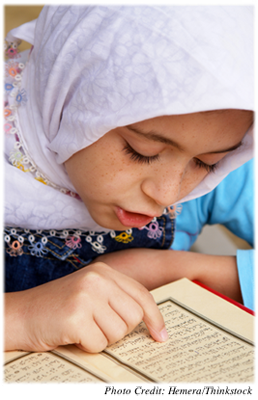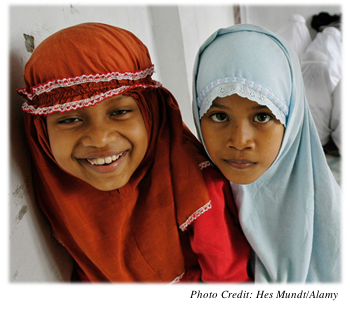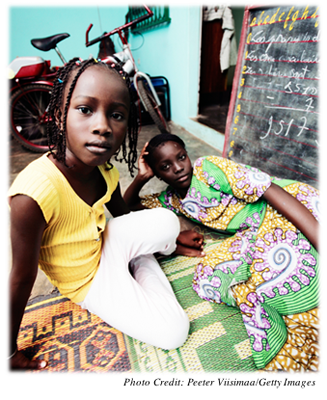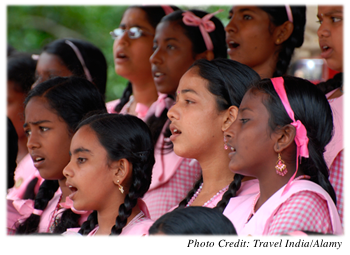Educating the Girls of the World
Slide 1 of 12: Synopsis

Author
Pauline Davey Zeece, University of Nebraska – Lincoln
Synopsis
This activity focuses on the importance of education for all children, including girls. After briefly examining the influence of culture on gender and sex differences and gender identity, thinking and schooling are viewed from a sociocultural perspective. Video clips present the situation of girls’ education from cultures and countries around the world.
References
UNICEF. (2006). State of the World’s Children 2006: Excluded and invisible. Retrieved May 20, 2007, from http://www.unicef.org/sowc06/fullreport/chapters.php
UNGEI. (2007). United Nations Girls’ Education Initiative/Global Monitoring Report-2006. Children’s Rights. Retrieved May 20, 2007, from http://www.ungei.org/resources/index_581.html?q=printme
United Nations. (2007). UN Millennium Development Goals. Retrieved May 20, 2007, from http://www.un.org/millenniumgoals/
Wilson, L. (2007). What is curriculum and what are the types of curriculum? Retrieved May 20, 2007, from http://www.uwsp.edu/Education/lwilson/curric/curtp.htm
World Bank. (2007). World Bank Report: Girls’ Education. Retrieved May 20, 2007, from http://www.worldbank.org (Select Topics > Education > Girls’ Education)
Slide 2 of 12: Boys Will Be Boys, and Girls Will Be Girls
- Chapters
- descriptions off, selected
- captions settings, opens captions settings dialog
- captions off, selected
- English Captions
This is a modal window.
Beginning of dialog window. Escape will cancel and close the window.
End of dialog window.
This is a modal window. This modal can be closed by pressing the Escape key or activating the close button.
This is a modal window.
Social scientists distinguish between sex differences, which are the biological differences between males and females, and gender differences, which are the culturally-imposed differences in the roles and behaviors of males and females. Every society has fundamental values and attitudes regarding preferred behavior for men and women. Every culture teaches these values and attitudes to their young. Even though the particular tasks assigned to males and females vary from one society to another, this passing down of values, attitudes, and knowledge of skills and tasks helps young children to establish a gender identity in the context of their culture.
Play the video to learn about two girls from Bangladesh and Mali.
Slide 3 of 12: A Sociocultural Perspective

The sociocultural perspective suggests that many traditional cultures emphasize easily recognized gender distinctions. In societies where adult activities and dress are strictly separated by gender, girls and boys quickly adopt the patterns of talking, behaving, and even thinking that are prescribed for their sex. Expectations, decisions, and outcomes related to schooling or formal education are often gender-based.
According to Erikson’s theory, school-aged children work to solve the crisis of industry versus inferiority. Children busily strive to master whatever abilities their culture values. They judge themselves as either industrious or inferior—that is, as competent or incompetent, productive or failing, winners or losers. Throughout the world, many children, especially girls, try to resolve this internal struggle without the benefit or guidance of a structured, school-based education.
Slide 4 of 12: School-Age Thinking and Curriculum

Experts agree that school-age children have a great capacity to learn. This is fueled by their emerging concrete operational thinking. Mastery of logical principles, including conservation, classification, identity, reversibility, and reciprocity, are first grasped between ages 5 and 7 and then more securely between ages 7 and 11. Across the globe, school-age children use this thinking to better learn concepts, ideas, and skills that are valued by their cultures.
Governments and schools select what should be taught, for how many years, by and to whom, and with what type of funding. The content and context of schooling is influenced, in part, by the curriculum, but curriculum is more than the formal, written, instructional agenda that guides children’s experiences in school. It also contains a hidden entity.
Slide 5 of 12: The Hidden Curriculum

Hidden curriculum is the unspoken and often unrecognized lessons that children learn when they are in school and when they are excluded from school. It refers to the kind of covert lessons and learning children derive from the very nature and organizational design of the educational environment and enrollment policies as well as the behaviors, expectations, and attitudes of parents, teachers, administrators, and the larger society (Wilson, 2007). When any group of children is under-represented or prohibited from attending school, this is a powerful and sobering message to all children!
Slide 6 of 12: Educating Children of the World
- Chapters
- descriptions off, selected
- captions settings, opens captions settings dialog
- captions off, selected
- English Captions
This is a modal window.
Beginning of dialog window. Escape will cancel and close the window.
End of dialog window.
This is a modal window. This modal can be closed by pressing the Escape key or activating the close button.
This is a modal window.
Universal education has been difficult to achieve. After decades of commitments from countries and groups around the world, more than 75 million of the world’s children still do not have access to even a primary education. An additional 100 million children do not progress beyond the equivalent of an elementary-school level, and nearly a billion people are illiterate throughout their lives. Two-thirds of this latter group is female (UNICEF, 2006; UNGEI, 2007).
Globally, many girls are denied access to formal schooling. In rural areas, they are often the most disadvantaged social group. They are unable to challenge the status quo from their position of acute vulnerability (UNESCO, 2006). Between 1999 and 2004, the worldwide number of children not in school declined rapidly from about 100 million to 77 million. Three-quarters of the decrease (16.7 million) took place between 2002 and 2004. However, girls still constitute 57 percent of all out-of-school children, down from 59 percent in 1999. For every 100 boys out-of-school worldwide, there are 117 girls out-of-school. Gender disparities in education still remain predominant in the Arab States (134 girls out-of-school for every 100 boys), in South and West Asia (129 girls out-of-school for every 100 boys), and in countries like Yemen (184 girls out-of-school for every 100 boys), Iraq (176 girls out-of-school for every 100 boys), India (136 girls out-of-school for every 100 boys), and Benin (136 girls out-of-school for every 100 boys) (World Bank, 2007).
Play the video to learn of the numerous barriers that prevent girls from going to school.
Slide 7 of 12: Educating Children of the World (continued)
- Chapters
- descriptions off, selected
- captions settings, opens captions settings dialog
- captions off, selected
- English Captions
This is a modal window.
Beginning of dialog window. Escape will cancel and close the window.
End of dialog window.
This is a modal window. This modal can be closed by pressing the Escape key or activating the close button.
This is a modal window.
Slide 8 of 12: Taking Up the Education Challenge
- Chapters
- descriptions off, selected
- captions settings, opens captions settings dialog
- captions off, selected
- English Captions
This is a modal window.
Beginning of dialog window. Escape will cancel and close the window.
End of dialog window.
This is a modal window. This modal can be closed by pressing the Escape key or activating the close button.
This is a modal window.
Today, HIV/AIDS, conflicts, emergencies and other fragile situations, gender-based violence, and information technology gender gaps (UNESCO, 2006) have emerged as challenges that reduce girls’ enrollment in primary, secondary, and tertiary education.
Play the video to learn of efforts, including those supported by the UN, to help girls worldwide obtain an education.
Slide 9 of 12: Assessment: Check Your Understanding

Slide 10 of 12: Assessment: Check Your Understanding

Slide 11 of 12: Assessment: Check Your Understanding

Slide 12 of 12: Assessment: Check Your Understanding
- Chapters
- descriptions off, selected
- captions settings, opens captions settings dialog
- captions off, selected
- English Captions
This is a modal window.
Beginning of dialog window. Escape will cancel and close the window.
End of dialog window.
This is a modal window. This modal can be closed by pressing the Escape key or activating the close button.
This is a modal window.
Congratulations! You have completed this activity.Total Score: x out of x points (x%) You have received a provisional score for your essay answers, which have been submitted to your instructor.